|
|
|
Sort Order |
|
|
|
Items / Page
|
|
|
|
|
|
|
| Srl | Item |
| 1 |
ID:
099108
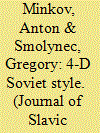

|
|
|
|
|
| Publication |
2010.
|
| Summary/Abstract |
Part two of the authors' study of the Soviet involvement in Afghnistan deals with social development as one of the elements of the overall Soviet state-building strategy. The authors conclude that Soviet social development policies, the effects of Soviet inspired nationalities policy, and the heavy-handed response to the opponents of the Peoples Democratic Party of Afghanistan (PDPA) alienated much of the population. The government in Kabul was able to attract some support primarily among the urban and the more educated stratum of the society, but, on the whole, remained isolated from the rural masses. The inability to engage a significant number of people in the state building process seriously undermined the Sovietization strategy. Soviet efforts to raise literacy levels among Afghans, and to enfranchise Afghan women could be qualified as relatively, if ephemerally, successful.
|
|
|
|
|
|
|
|
|
|
|
|
|
|
|
|
| 2 |
ID:
107855
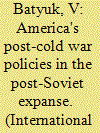

|
|
|
| 3 |
ID:
177710
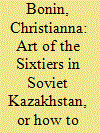

|
|
|
|
|
| Summary/Abstract |
The artists of the Sixtiers generation in Soviet Kazakhstan have typically been understood as the creators of an authentic Kazakh style. This article demonstrates that a web of constructed vectors helped consolidate art as ‘Kazakh’ in the 1960s and early 1970s. I argue that the Sixtiers mined the history of nomadic populations in Central Asia for site-specific cultural forms as a means to connect with an expanding art world and the global context of decolonialization. Neither wholly official nor countercultural, the Sixtiers produced a cultural milieu that stretched the limits of the sayable in late Soviet socialism and defined the margins of modernity with which Kazakh artists continue to contend.
|
|
|
|
|
|
|
|
|
|
|
|
|
|
|
|
| 4 |
ID:
104054
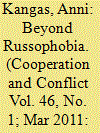

|
|
|
|
|
| Publication |
2011.
|
| Summary/Abstract |
The article offers a practice-based analysis of Finland's relationships with Russia. It works on the basis of ideas that have been presented in conjunction with the so-called practice and pragmatist turns in international relations. After identifying three key schools of thought in previous research on Finnish-Russian relations - primordialist, instrumentalist and identity-based - the article moves on to give a practice turn inspired account of the ways in which the proximity of Russia was dealt with in Finland during the inter-war period. Combining insights from the work of Pierre Bourdieu and Charles S. Peirce, it introduces a research design built with the help of such analytical tools as the doubt-belief model of social action, relational properties and fields. These tools are then applied on research materials that comprise Finnish parliamentary documents and political cartoons. The materials are argued to be particularly well suited for attempts to apply practice insights in actual research, as they simultaneously function as embodiments of meaningful patterns of social and political activity and actively correlate with the urgencies of the contexts in which they appear.
|
|
|
|
|
|
|
|
|
|
|
|
|
|
|
|
| 5 |
ID:
163142
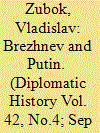

|
|
|
|
|
| Summary/Abstract |
Vladimir Putin's announcement to run for another term makes him the most durable leader in Russia's recent history. Some think of Putin as "the new Brezhnev," who might die in office many years from now. But is it fair to compare Putin to Leonid Brezhnev? Can the Soviet past provide any lesson's for Russia's present and future? What should the United States expect for Putin?
|
|
|
|
|
|
|
|
|
|
|
|
|
|
|
|
| 6 |
ID:
092591
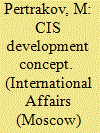

|
|
|
| 7 |
ID:
140491
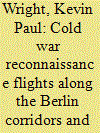

|
|
|
|
|
| Summary/Abstract |
During the Cold War, Soviet and East German military units, equipment and activities around Berlin were high priority targets for Western military intelligence agencies. This article examines the imagery gathering undertaken by British, French and US reconnaissance flights along the Berlin Air Corridors and inside the Berlin Control Zone. The quantity of information was effectively multiplied because of the close cooperation between the Western allies and coordination with Allied Military Liaison Mission ‘ground tours’. This cooperation generally went further than has been publicly acknowledged by individual governments. This paper contends that the collaboration provided the most comprehensive and regular collection of imagery on Soviet and East German military units for the duration of the Cold War. It contributed to a multi-dimensional picture of Soviet and German Democratic Republic capabilities and intentions. Soviet motives for generally not interfering with those missions on a regular basis are considered.
|
|
|
|
|
|
|
|
|
|
|
|
|
|
|
|
| 8 |
ID:
098019
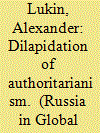

|
|
|
| 9 |
ID:
192656
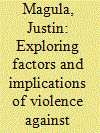

|
|
|
|
|
| Summary/Abstract |
The Soviet-Afghan War serves as a significant case study to understand why states resort to violent acts against civilians during war. This study takes a multidimensional approach, examining strategic, operational, and individual factors and applying theories of violence and mass killing. By analyzing the conditions that led the Soviets to target civilians, this investigation identifies a nexus of interconnected factors. At the strategic level, Soviet leaders pursued a swift victory to establish a Communist client regime while minimizing casualties and controlling information flow. Operationally, the ill-preparedness of the Red Army for counterinsurgency warfare, coupled with an entrenched organizational culture, led to the adoption of counterproductive enemy-centric tactics against Afghan noncombatants. Additionally, inadequate training, prolonged deployments, and a lack of disciplinary measures at the individual level contributed to the perpetration of violent acts. Understanding the underlying causes of violence against civilians, particularly in the context of Russian forces, holds practical importance. This knowledge can assist policymakers in devising strategies that mitigate wartime violence and enhance the protection of citizens. Drawing parallels to contemporary conflicts involving Russia, the study concludes by recommending future research directions and emphasizing the relevance of comprehending the targeting of noncombatants in ongoing conflicts, notably the Russian-Ukrainian conflict.
|
|
|
|
|
|
|
|
|
|
|
|
|
|
|
|
| 10 |
ID:
146362
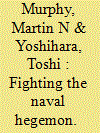

|
|
|
|
|
| Summary/Abstract |
Geography gives strategy its context. Secure from land invasion, Great Britain and later the United States employed a distinctive form of sea power to defeat their adversaries. Both used their navies to control sea-lanes and vital choke points and to apply direct pressure along enemy coastlines. Through their dominance of the oceans they were able to shape the political and economic order of the world. It is fair to say that what amounts to the Anglo-American school of naval power has demonstrated its efficacy time after time: over the past 250 years these two powers have, singly or together, and always with other allies, defeated every opponent that has attempted to change that order
|
|
|
|
|
|
|
|
|
|
|
|
|
|
|
|
| 11 |
ID:
167969
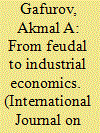

|
|
|
| 12 |
ID:
106922
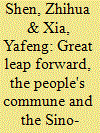

|
|
|
|
|
| Publication |
2011.
|
| Summary/Abstract |
Utilizing recently available Chinese and Russian archival sources and pertinent media reports, this article attempts to unravel the truth on the connection between the Great Leap Forward/the People's Commune Movement and the Sino-Soviet split. It aims to address the following questions: what are the actual divergences between China and the Soviet Union on the Great Leap Forward and the People's Commune Movement? How did Mao react to the Soviet attitude? How did Mao's reaction directly connect to the Sino-Soviet split? It reveals the actual divergences between Mao and Khrushchev over the Great Leap Forward and the People's Commune Movement.
|
|
|
|
|
|
|
|
|
|
|
|
|
|
|
|
| 13 |
ID:
138249
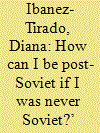

|
|
|
|
|
| Summary/Abstract |
Based on anthropological fieldwork conducted in the Kulob region of southern Tajikistan, this paper examines the extent to which the existing periodization ‘Soviet/post-Soviet’ is still valid to frame scholarly works concerning Central Asia. It does so through an analysis of ‘alternative temporalities’ conveyed by Kulob residents to the author. These alternative temporalities are fashioned in especially clear ways in a relationship to the physical transformations occurring to two types of housing, namely flats in building blocks and detached houses. Without arguing that the categories ‘Soviet’ and ‘post-Soviet’ have become futile, the author advocates that the uncritically use of Soviet/post-Soviet has the unwanted effect of shaping the Central Asian region as a temporalized and specialized ‘other’.
|
|
|
|
|
|
|
|
|
|
|
|
|
|
|
|
| 14 |
ID:
154372
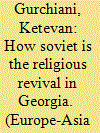

|
|
|
|
|
| Summary/Abstract |
This article explores everyday religiosity in post-Soviet Georgia based on multi-sited fieldwork and applying a genealogical approach. It looks at the use of tactics in negotiations between priests and believers. The article sees negotiations, prevalent in domestic religiosity and embodied practices, as a continuation of everyday Soviet tactics, particularly informal networks (Blat) and moonlighting (Khaltura). To understand how negotiations lead to greater control and an increase in religiosity, the article explores important features of the Georgian Orthodox Church and its specific development. The article concludes that tactics in this specific context strengthen the more powerful and reproduce dependency.
|
|
|
|
|
|
|
|
|
|
|
|
|
|
|
|
| 15 |
ID:
084523
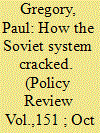

|
|
|
| 16 |
ID:
153008
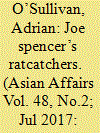

|
|
|
|
|
| Summary/Abstract |
During the Anglo-Soviet occupation of Persia (Iran), the Tehran-based Defence Security Office was responsible for protecting from Nazi subversion and sabotage three potential strategic targets: the vital oilfields, pipelines, and refineries of Khuzistan; the Lend-Lease supply route between the Persian Gulf and the Soviet Union; and the security of the Persian polity itself. Against all odds, under the command of Lt Col E.L. ‘Joe’ Spencer, this small but effective British/Indian security-intelligence unit succeeded in neutralising the Nazi threat, in capturing all German operatives on Persian soil, and in maintaining the security of a territory five times the size of Britain.
|
|
|
|
|
|
|
|
|
|
|
|
|
|
|
|
| 17 |
ID:
091883


|
|
|
|
|
| Publication |
2009.
|
| Summary/Abstract |
When president Bill Clinton described the Comprehensive Test Ban Treaty (CTBT) as the longest-sought, hardest fought prize in arms control history, he was not exaggerationg.
|
|
|
|
|
|
|
|
|
|
|
|
|
|
|
|
| 18 |
ID:
106602
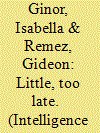

|
|
|
|
|
| Publication |
2011.
|
| Summary/Abstract |
The authors' previous research has established that the 1967 Arab-Israeli Six-Day War resulted from a deliberate Soviet plan to provoke Israel into a pre-emptive strike, which would legitimize and trigger a massive Soviet military intervention to aid an Egyptian-Syrian counteroffensive. However, US documents released until recently provided no evidence that the American intelligence community, and particularly the CIA, detected this threat or informed the political leadership about it - even though some indications were picked up at the field level. A newly declassified, retrospective report appears for the first time to show that there was awareness of major components of the Soviet operation (preparations for a naval landing and parachute drop). But closer scrutiny finds that this report reflects Soviet propaganda more than factual intelligence - thus further tarnishing what has hitherto been held as an outstanding achievement for the Agency and its chief.
|
|
|
|
|
|
|
|
|
|
|
|
|
|
|
|
| 19 |
ID:
162235
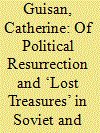

|
|
|
|
|
| Summary/Abstract |
Drawing from the central notion in Russian culture of resurrection, and from Hannah Arendt’s concept of political ‘lost treasures’, this article analyses initiatives for democratisation during the Soviet Thaw (1956–1964) and perestroika (1985–1991); and current attempts to recall the legacy of medieval Pskov and Novgorod’s republican institutions. Retrieving memories of civic action matters intellectually and politically because it roots Russian democratisation in alternative national traditions, which, curiously, both Russian democratic activists and Putin supporters dismiss today. The empirical data come from interviews, ethnographic observations, and studies on Russian/Soviet politics and memory.
|
|
|
|
|
|
|
|
|
|
|
|
|
|
|
|
| 20 |
ID:
097763
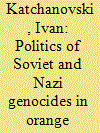

|
|
|
|
|
| Publication |
2010.
|
| Summary/Abstract |
This article examines policies and public attitudes concerning the issue of Soviet and Nazi genocides in Ukraine after the 'Orange Revolution'. The central question is whether such factors as regional political culture affect contemporary policies and public attitudes towards these important historical issues. The article uses a 2008 survey conducted for this study by the Kyiv International Institute of Sociology to analyse determinants of public attitudes concerning the question of whether Soviet and the Nazi policies were genocidal. It finds that regional political culture is the most significant factor affecting policies and attitudes towards the Soviet genocide in Ukraine.
|
|
|
|
|
|
|
|
|
|
|
|
|
|
|
|
|
|
|
|
|